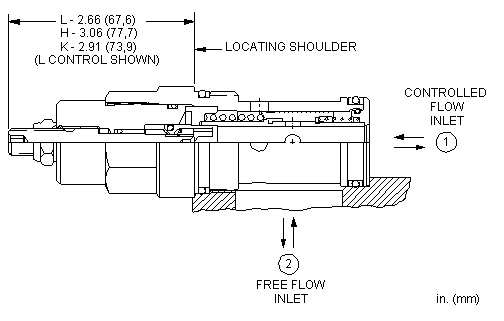Fully adjustable pressure compensated flow control valve with reverse flow check

Fully adjustable, pressure-compensated flow controls with reverse-flow check provide precise flow regulation for meter-in or meter-out applications where there may be wide pressure fluctuations. They are infinitely adjustable from nearly closed up to the maximum flow. An integral high-capacity check valve provides unrestricted flow from port 2 to port 1.
- All 2-port flow control cartridges are physically and functionally interchangeable (i.e. same flow path, same cavity for a given frame size). However, cartridge extension dimensions from the mounting surface may vary.
- A balanced adjustment mechanism allows for easy adjustment even at high pressures.
- The sharp-edged orifice design minimizes flow variations due to viscosity changes.
- Minimum leakage is .2 gpm (0,8 L/min) when the adjustment mechanism is turned to the shut-off position.
- Cartridges configured with EPDM seals are for use in systems with phosphate ester fluids. Exposure to petroleum based fluids, greases and lubricants will damage the seals.
| Cavity | T-16A |
| Series | 3 |
| Capacity | 25 gpm95 L/min. |
| Maximum Operating Pressure | 5000 psi350 bar |
| Adjustment - No. of CCW Turns from Fully Closed to Fully Open | 55 |
| Valve Hex Size | 1 1/4 in.31,8 mm |
| Valve Installation Torque | 150 - 160 lbf ft203 - 217 Nm |
| Adjustment Screw Internal Hex Size | 5/32 in.4 mm |
| Locknut Hex Size | 9/16 in.15 mm |
| Locknut Torque | 80 - 90 lbf in.9 - 10 Nm |
| Model Weight | 1.25 lb0,60 kg |
| Seal kit - Cartridge | Buna: 990016007 |
| Seal kit - Cartridge | EPDM: 990016014 |
| Seal kit - Cartridge | Polyurethane: 990016002 |
| Seal kit - Cartridge | Viton: 990016006 |
We claim +/- 10%. We set to +/- 5% in production testing to allow for differences in customers' conditions. If you want accuracy, stay in the bottom 2/3rds of the range. Our 12 gpm (45 L/min.) flow controls are quite flat at 9 gpm (34 L/min.) and dead flat below 6 gpm (23 L/min.), until you get to the bottom of the range. Below about .25 gpm (1 L/min.), spool leakage and orifice conditions start to limit accuracy.
I am afraid not. Unless you are overflowing your current valve and correctly size ours, you are not likely to notice any improvement. Priority flow controls are not efficient devices. They are an easy way to get more than 1 source of oil from 1 pump but they can generate a lot of heat. Try to size your actuators so the pressures are similar on both the priority and the bypass circuits. If you can't do that, try to have the lower flow leg be the lower pressure. The pump pressure is determined by whichever leg is higher and if there is flow that is taking a pressure drop that is not doing work it is creating heat.
All flow is blocked, hence the term priority. The priority flow has to be satisfied.
The valve acts as a 2 port restrictive flow control.
The spring force in our flow controls equates to about 100 psi (7 bar). This is high enough to give the valves acceptable capacity and not too high for proper circuit operation. 100 psi (7 bar) is the spring force; at the upper end of the flow control's range, the drop through the valve will be as high as 250 psi (17 bar) before it starts modulating.
There are exactly 250 Sun drops in a cubic inch or 15 in a cc.
In a meter-in flow control circuit if the pump is set at 3000 psi and the load is 2000 psi the drop through the flow control is 1000 psi. In a meter-out circuit with the load at 2000 psi the drop through the flow control is 2000 psi.
- Sun Offers Zinc-Nickel Plating for Corrosion Resistance
- Sun Cartridges with EPDM Seals
- QuickDesign with SmartConnect Offers Drag-and-Drop Schematic Tool
- Sun Expands Corrosion-Resistant Solutions
- Sun's New FLeX Series Solenoid Valves & Coils
- Check Valves, Flow Control and Priority Flow Control Valves Technical Tips
- Manufacturing Sun Cartridge Cavities (522.27 KB)
- Check, Flow Control, and Priority Flow Control Valves (537.44 KB)





